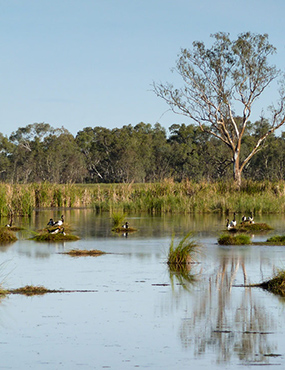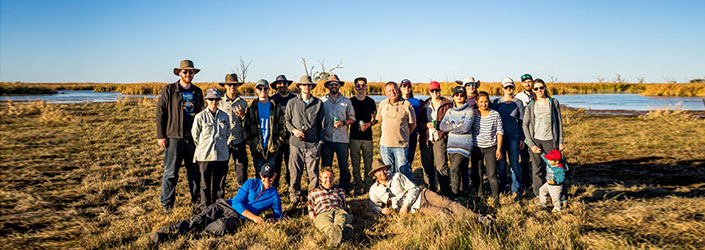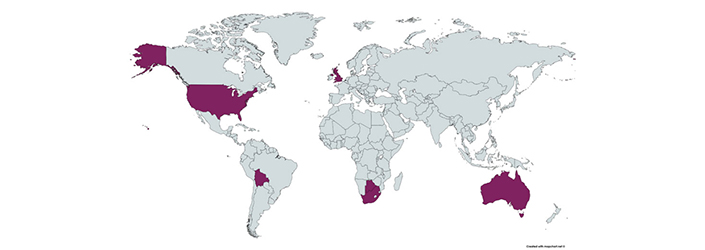A contradiction providing critical ecosystem services
Many semi-arid and arid landscapes (drylands) around the world host rivers, shallow lakes, marshes, swamps, and various periodically wet areas that provide critical ecosystem services.

Wetlands in drylands
Our researchers engage with collaborators and communities widely across Australia, southern Africa, the Americas and Europe to understand why these wetlands are so important, how they function, and what threatens them.
We also examine how an improved understanding of rivers and wetlands can be translated to support and enhance their conservation and management.
We also convene and participate in workshops and a range of on-ground and online activities to facilitate communication of novel ideas and findings, and to kick-start and maintain collaborative and interdisciplinary partnerships and projects.
Much of this is done in conjunction with other members of the international Wetlands in Drylands Research Network.
Macquarie University NSW 2109

Wetlands in Drylands Research Network members in the Macquarie Marshes, NSW, Australia (photo credit Gavin Smith).
Dr Tim Ralph
Macquarie University
Dr Zacc Larkin
Macquarie University
Associate Professor Paul Hesse
Macquarie University
Professor Kirstie Fryirs
Macquarie University
- state government agencies
- Australian Commonwealth Government
- government
- community-based conservation and environmental management groups
- local land service agencies and communities
- secondary school and university students.
- Dr Yoshi Kobayashi, Science Division, NSW Department of Planning, Industry and Environment, Sydney, Australia
- Professor Stephen Tooth, Department of Geography and Earth Sciences, Aberystwyth University, United Kingdom
- Dr Marc Humphries, School of Chemistry, University of the Witwatersrand, Johannesburg, South Africa
- Emeritus Professor Terence McCarthy, School of Geosciences, University of the Witwatersrand, Johannesburg, South Africa
- Staff from several NSW Department of Planning, Industry and Environment divisions, including
The research seeks to document and quantify river and wetland forms and processes, water quality and aquatic ecosystem functions, and geoecological responses to human disturbance. This helps with interpretation of long-term landscape evolution, and assessment of the hazards and risks of future pressures on wetlands in drylands.
This work is published individually or collaboratively in peer-reviewed journals and books, and is translated into outreach and media articles, secondary school review papers, and booklets and pamphlets to enhance dissemination and uptake in government agencies and local communities.
The research is often targeted towards and applied by partners and end-users who use the improved understanding of hydrology, geomorphology and ecology in wetlands in drylands to assist water and wetland decision-making, inform conservation and management planning, and to engage with local communities on a spectrum of environmental issues.
Key contributions to environmental conservation, management and planning include inputs to:
- Macquarie Marshes Ramsar Site: Article 3.2 response strategy. 2013. OEH2013/0104. Office of Environment and Heritage, NSW Department of Premier and Cabinet, Sydney, 27 pp.
- Macquarie Marshes Ramsar Site: Ecological character description Macquarie Marshes Nature Reserve and U-block components. 2012. OEH 2012/0517. Office of Environment and Heritage, NSW Department of Premier and Cabinet, Sydney, 144 pp.
- Macquarie Marshes Adaptive Environmental Management Plan: Synthesis of information projects and actions. 2010. DECCW 2010/224. NSW Wetland Recovery Program, Department of Environment, Climate Change and Water NSW, Sydney, 112 pp.
Related outputs from the Wetlands in Drylands Research Network include:
Understanding and management of wetlands in drylands
- Identifying threshold responses of Australian Dryland rivers to future hydro climatic change.
- Floodplain wetland biota in the Murray-Darling basin: water and habitat requirements.
- 10 reasons why the geomorphology of wetlands is important.
- A nested hierarchical perspective to enhance interpretations and communication in fluvial geomorphology for use in water resources management: Lessons from the Okavango Delta, Botswana.
- Matching research and policy tools to scales of climate-change adaptation in the Murray-Darling, a large Australian river basin: a review.
- The use of representative species as surrogates for wetland inundation.
Geomorphology of wetlands in drylands
- Product vs process? The role of geomorphology in wetland characterization.
- The geomorphology of wetlands in drylands: Resilience, nonresilience, or …?
- Cascades of sub‐decadal, channel‐floodplain changes in low‐gradient, non‐vegetated reaches near a dryland river terminus: Salar de Uyuni, Bolivia.
- The interplay between extrinsic and intrinsic controls in determining floodplain wetland characteristics in the South African drylands.
- Timescales, mechanisms, and controls of incisional avulsions in floodplain wetlands: Insights from the Tshwane River, semiarid South Africa.
- Wandering wetlands: spatial patterns of historical channel and floodplain change in the Ramsar-listed Macquarie Marshes, Australia.
- The role of airborne dust in the growth of tree islands in the Okavango Delta, Botswana.
- Downstream hydrogeomorphic changes along the Macquarie River, southeastern Australia, leading to channel breakdown and floodplain wetlands.
- 137Cs and 210Pb derived sediment accumulation rates and their role in the long-term development of the Mkuze River floodplain, South Africa.
- Wetlands in drylands: key geomorphological and sedimentological characteristics, with emphasis on examples from southern Africa.
Long-term river and wetland change in drylands
- Palaeohydrology of lowland rivers in the Murray-Darling Basin, Australia.
- Dramatic reduction in size of the lowland Macquarie River in response to Late Quaternary climate-driven hydrologic change.
- Paleoecological responses to avulsion and floodplain evolution in a semiarid Australian freshwater wetland.
Aquatic ecosystem function of wetlands in drylands
- Influence of historical inundation frequency on soil microbes (Cyanobacteria, Proteobacteria, Actinobacteria) in semi-arid floodplain wetlands.
- Dunphy Lake in Warrumbungle National Park, NSW: aquatic animal community after the Wambelong fire in 2013.
- Spatial dissimilarities in plankton structure and function during flood pulses in a semi-arid floodplain wetland system.
- Gross primary productivity of phytoplankton and planktonic respiration in inland floodplain wetlands of southeast Australia: habitat‐dependent patterns and regulating processes.
- Longitudinal spatial variation in ecological conditions in an in-channel floodplain river system during flow pulses.
Conference proceedings and blogs
Countries where impact occurred
The USA, Bolivia, the UK, Botswana, South Africa, Australia.
